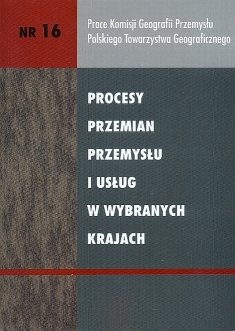Location differences of services and industry: A Central European dichotomy
DOI:
https://doi.org/10.24917/20801653.16.3Słowa kluczowe:
services, industry, location, Central European, dichotomyAbstrakt
In post-socialist spatial restructuring, over-industrialised economies experienced a period of intense tertiarisation and the decline of industrial employment. However, the role of services in this process shows strong sectoral and spatial differences. In addition to structural correction, tertiarisation may be interpreted as the bearer of economic modernisation, but also a symptom of weakness where services dominate due to an absence of economic alternatives. Advanced business services are strongly concentrated in central regions, while elsewhere economic growth is still mainly driven by industry, whose location shows high path-dependency going back to the quantitative and qualitative factor supply, as well as a broader societal and institutional background that encourages the reproduction of industrial milieus.Using empirical evidence from Central and South-Eastern European countries, the author examines how the sub-national location differences of services and industry reshape and recreate the region’s traditional centre-periphery differences: evidence points to differentiation between not only central and non-central regions, but also the Central and South-Eastern European group of new EU members and candidate states.Downloads
Bibliografia
Audretsch, D. B., Carree, M. A., van Stel, A. J., Thurik, A. R., 2000, Impeded industrial restructuring. The growth penalty. Tinbergen Institute, Amsterdam.
Barta, Gy, Kukely, Gy., 2008, Re-industrialisation in the world and in Hungary, European Spatial Research and Policy, No. 2, pp. 5–26.
Enyedi, Gy., 1978, Kelet-Közép-Európa gazdaságföldrajza. [The economic geography of Eastern Central Europe]. Közgazdasági és Jogi Könyvkiadó, Budapest.
Faragó, L., 2004, The general theory of public (spatial) planning. The social technique for creating the future. Discussion Papers No. 43. Centre for Regional Studies, Pécs.
Gál, Z., 2005, The development and the polarised spatial structure of the Hungarian banking system in a transforming economy, [in:] Barta, Gy., G. Fekete, É., Kukorelli Szörényiné, I., Timár, J. eds., Hungarian spaces and places: Patterns of transition. Centre for Regional Studies, Pécs, pp. 197–219.
Grabher, G., 1993, The weakness of strong ties. The lock-in of regional development in the Ruhr area. [in:] Grabher, G. ed., The embedded firm. On the socioeconomics of industrial networks. Routledge, London, pp. 255–277.
Guerrieri, P., 1998, Trade patterns, Foreign Direct Investment, and industrial restructuring of Central and Eastern Europe. [in:] Zysman, J., Schwartz, A. eds., Enlarging Europe: The industrial foundations of a new political reality. University of California at Berkeley, Berkeley, pp. 130–156.
Gulyás, L., 2008, Sustainable growth in the labour market, European attempts for reducing unemploy ment, Annals of the Faculty of Economics, No 19. Novi Sad University Faculty of Economics, Novi Sad.
Horváth, Gy., 2009, Cohesion deficiencies in Eastern and Central Europe – Inequalities of regional research area. Discussion Papers No. 72. Centre for Regional Studies, Pécs.
Hudson, R., 1994, Institutional change, cultural transformation and economic regeneration: Myths and realities from Europe’s Old Industrial Areas. [in:] Amin, A., Thrift, N. eds., Globalization, institutions, and regional development in Europe. Oxford University Press, Oxford, pp. 198–216.
Kornai, J., 1993, Transzformációs visszaesés. Egy általános jelenség vizsgálata a magyar fejlődés példáján. [Transformation recession. Examination of a general phenomenon on the example of Hungarian development.], Közgazdasági Szemle No. 7–8, pp. 569–599.
Lefilleur, J., 2008, Geographic reorganisation of the European automobile sector. What role for the Central and East European countries in an enlarged European Union? An empirical approach, Eastern European Economics, No. 5, pp. 69–91.
Pavlínek, P., Domański, B., Guzik, R., 2009, Industrial upgrading through Foreign Direct Investment in Central European automotive manufacturing, European Urban and Regional Studies, No. 1, pp. 43–63.
Póla, P., 2009, Az újraiparosítás intézményi feltételei. [The institutional conditions of reindustrialisation]. [in:] Fodor, I., ed., A régiók újraiparosítása. A Dél-Dunántúl esélyei. MTA Regionális Kutatások Központja, Pécs, pp. 69–78.
Soós Károly, A., 2002, Az átmeneti gazdaságok EU-exportja nemzetközi összehasonlításban, 1993– 2000. [The EU export of transition economies in international comparison, 1993–2000], Közgazdasági Szemle, No. 12., pp. 1063–1080.
Steiner, M., 1985, Old Industrial Areas: A theoretical approach, Urban Studies, No. 5, pp. 387–398.
Winiecki, J., 1986, Az ipar túlméretezettsége a kelet-európai szocialista országokban: tények, okok, következmények. [The oversized industry in Eastern European socialist states: Facts, causes and consequences], Közgazdasági Szemle, No. 5, pp. 579–592.
Pobrania
Opublikowane
Jak cytować
Numer
Dział
Licencja
Artykuły publikowane są zgodnie z warunkami licencji Creative Commons (CC BY-ND 4.0; uznanie autorstwa-bez utworów zależnych).

